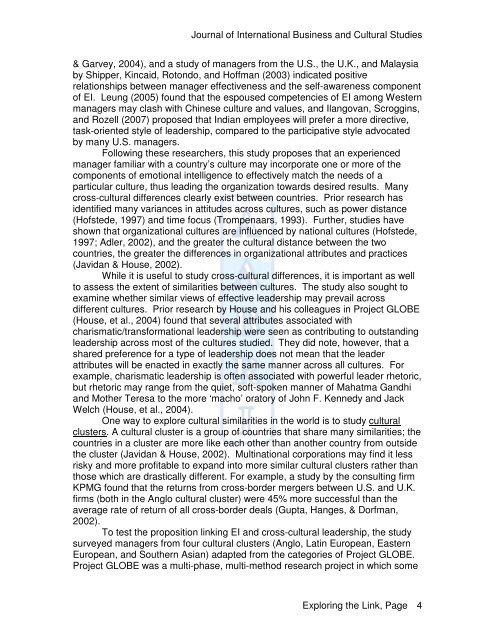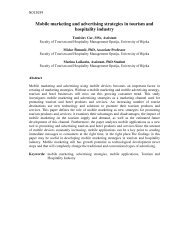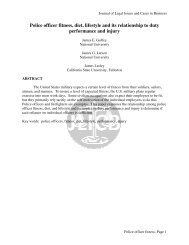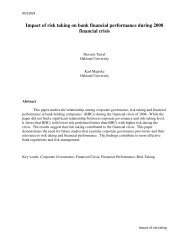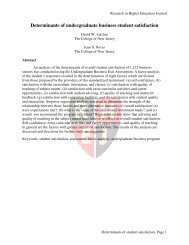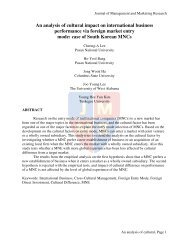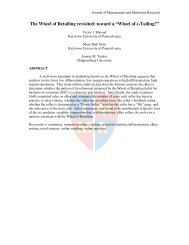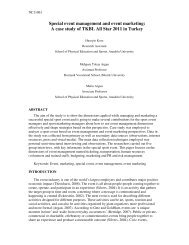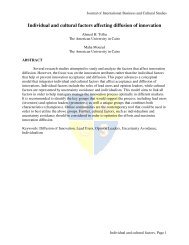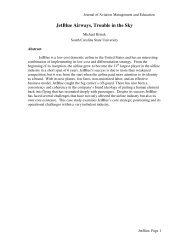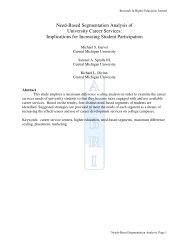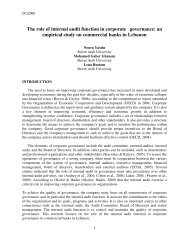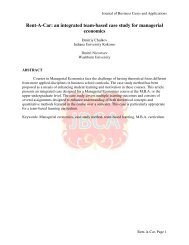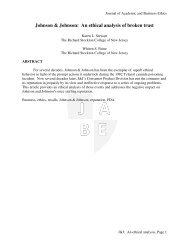Exploring the Link between Emotional Intelligence and Cross ...
Exploring the Link between Emotional Intelligence and Cross ...
Exploring the Link between Emotional Intelligence and Cross ...
You also want an ePaper? Increase the reach of your titles
YUMPU automatically turns print PDFs into web optimized ePapers that Google loves.
Journal of International Business <strong>and</strong> Cultural Studies<br />
& Garvey, 2004), <strong>and</strong> a study of managers from <strong>the</strong> U.S., <strong>the</strong> U.K., <strong>and</strong> Malaysia<br />
by Shipper, Kincaid, Rotondo, <strong>and</strong> Hoffman (2003) indicated positive<br />
relationships <strong>between</strong> manager effectiveness <strong>and</strong> <strong>the</strong> self-awareness component<br />
of EI. Leung (2005) found that <strong>the</strong> espoused competencies of EI among Western<br />
managers may clash with Chinese culture <strong>and</strong> values, <strong>and</strong> Ilangovan, Scroggins,<br />
<strong>and</strong> Rozell (2007) proposed that Indian employees will prefer a more directive,<br />
task-oriented style of leadership, compared to <strong>the</strong> participative style advocated<br />
by many U.S. managers.<br />
Following <strong>the</strong>se researchers, this study proposes that an experienced<br />
manager familiar with a country’s culture may incorporate one or more of <strong>the</strong><br />
components of emotional intelligence to effectively match <strong>the</strong> needs of a<br />
particular culture, thus leading <strong>the</strong> organization towards desired results. Many<br />
cross-cultural differences clearly exist <strong>between</strong> countries. Prior research has<br />
identified many variances in attitudes across cultures, such as power distance<br />
(Hofstede, 1997) <strong>and</strong> time focus (Trompenaars, 1993). Fur<strong>the</strong>r, studies have<br />
shown that organizational cultures are influenced by national cultures (Hofstede,<br />
1997; Adler, 2002), <strong>and</strong> <strong>the</strong> greater <strong>the</strong> cultural distance <strong>between</strong> <strong>the</strong> two<br />
countries, <strong>the</strong> greater <strong>the</strong> differences in organizational attributes <strong>and</strong> practices<br />
(Javidan & House, 2002).<br />
While it is useful to study cross-cultural differences, it is important as well<br />
to assess <strong>the</strong> extent of similarities <strong>between</strong> cultures. The study also sought to<br />
examine whe<strong>the</strong>r similar views of effective leadership may prevail across<br />
different cultures. Prior research by House <strong>and</strong> his colleagues in Project GLOBE<br />
(House, et al., 2004) found that several attributes associated with<br />
charismatic/transformational leadership were seen as contributing to outst<strong>and</strong>ing<br />
leadership across most of <strong>the</strong> cultures studied. They did note, however, that a<br />
shared preference for a type of leadership does not mean that <strong>the</strong> leader<br />
attributes will be enacted in exactly <strong>the</strong> same manner across all cultures. For<br />
example, charismatic leadership is often associated with powerful leader rhetoric,<br />
but rhetoric may range from <strong>the</strong> quiet, soft-spoken manner of Mahatma G<strong>and</strong>hi<br />
<strong>and</strong> Mo<strong>the</strong>r Teresa to <strong>the</strong> more ‘macho’ oratory of John F. Kennedy <strong>and</strong> Jack<br />
Welch (House, et al., 2004).<br />
One way to explore cultural similarities in <strong>the</strong> world is to study cultural<br />
clusters. A cultural cluster is a group of countries that share many similarities; <strong>the</strong><br />
countries in a cluster are more like each o<strong>the</strong>r than ano<strong>the</strong>r country from outside<br />
<strong>the</strong> cluster (Javidan & House, 2002). Multinational corporations may find it less<br />
risky <strong>and</strong> more profitable to exp<strong>and</strong> into more similar cultural clusters ra<strong>the</strong>r than<br />
those which are drastically different. For example, a study by <strong>the</strong> consulting firm<br />
KPMG found that <strong>the</strong> returns from cross-border mergers <strong>between</strong> U.S. <strong>and</strong> U.K.<br />
firms (both in <strong>the</strong> Anglo cultural cluster) were 45% more successful than <strong>the</strong><br />
average rate of return of all cross-border deals (Gupta, Hanges, & Dorfman,<br />
2002).<br />
To test <strong>the</strong> proposition linking EI <strong>and</strong> cross-cultural leadership, <strong>the</strong> study<br />
surveyed managers from four cultural clusters (Anglo, Latin European, Eastern<br />
European, <strong>and</strong> Sou<strong>the</strong>rn Asian) adapted from <strong>the</strong> categories of Project GLOBE.<br />
Project GLOBE was a multi-phase, multi-method research project in which some<br />
<strong>Exploring</strong> <strong>the</strong> <strong>Link</strong>, Page 4


